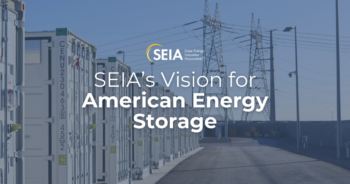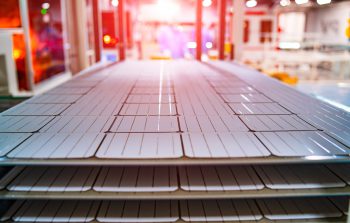About
Energy storage is crucial to the future of American energy security
With the support from policymakers, storage can help America keep the lights on.
The U.S. energy storage industry comprises hundreds of companies and thousands of American workers that manufacture, distribute and install residential, commercial and utility-scale energy storage systems across the country. Since the passage of the IRA, over 50 battery manufacturing facilities have been announced that will support nearly 17,000 jobs.

Decarbonizing the U.S. economy will require a significant increase in energy storage, so that clean, renewable energy can be used around the clock. Until the advent of affordable energy storage, fossil fuel generators were still needed to provide 24/7 power. However, nearly every major study shows that to decarbonize the electric sector, we need to develop the capacity to store clean energy for use when we need it.
Energy storage is a key technology to allow us to fully retire polluting natural gas, oil, and coal plants that emit harmful carbon dioxide and other polluting emissions. Energy storage is also key to maintaining power quality and resource adequacy as we add more renewable energy to the system. Energy storage provides balance to the grid, can support voltage, and smooth out power delivery in high-renewable scenarios.
Energy storage provides reliability and resilience during power outages
When the grid is down, energy storage can provide critical backup power to emergency shelters, hospitals, homes, businesses and even neighborhoods. When paired with solar, the power of energy storage to keep the lights on is enhanced because the batteries can recharge using solar even if the power outage lasts several days.
Energy storage can help manage bills and keep electric rates low
In many cases, storage can be used instead of traditional, costly, and slow investments in grid infrastructure. Utilities can use storage to increase capacity for new clean energy deployment, which can open up the benefits of clean energy to more customers. In states where net-metered electricity is billed based on “time-of-use” rates, like California and Hawaii, storage can help customers maximize the value of their solar system while providing valuable back-up power. Small resources, like home batteries, can be coordinated with grid needs to form “virtual power plants” that lower electric rates for everyone. Small businesses and industrial customers who pay high demand charges can use energy storage to save money on their electricity bills by using batteries to shift their loads away from peak times.
Over the next decade, the U.S. must dramatically ramp up standalone storage and solar + storage installations to achieve our economic and climate goals. Federal, state and local policy action is needed to unleash the potential of storage nationwide, and SEIA is leading that advocacy.
Energy Storage State By State
Explore the latest energy storage insights and policy updates in all 50 states and Washington, D.C.
our experts
Meet Our Experts
Joan White
Director of Storage and Interconnection PolicyJoan White is the Director of Storage and Interconnection Policy. She advances the rapid deployment of storage and solar through advocacy and as an expert witness in state and federal proceedings.
Energy storage needs the support of policymakers
SEIA is a fierce advocate for the energy storage industry. SEIA is the leading voice of open market competition in the electricity sector, and we have a unique role to play in ensuring that energy storage is deployed as quickly as possible, and at the lowest possible cost.
Storage can only thrive in a policy environment where it has equal access to the grid and where market barriers have been removed. To support the transition to a clean, reliable grid that maximizes the potential of energy storage, public policy investments must be made to support new storage projects and manufacturing facilities. Federal, regional, and state policy makers should focus on the following priorities to unleash the full potential of energy storage:
(1) Even the playing field by allowing energy storage to connect to the grid and be fairly compensated for services it can provide.
(2) Maintain and build financial support to get more projects off the ground and direct battery operations to support the grid.
(3) Deploy storage thoughtfully by providing extra incentives for vulnerable communities and mitigating risks.
Storage Advocacy at SEIA
SEIA is active at the federal and state level to advance our members’ policy priorities:
- Secure revenue streams and fair access to markets
- Interconnection: recognize flexibility
- Retail rates for charging should be rational and affordable
- Manufacturing: building an American energy storage value chain
- Lower barriers to siting
- State-level procurement programs with financial support
- IRA Implementation
- Expanding the deployment of storage to reach vulnerable communities
- Fire safety and risk management
- Supporting Long-duration energy storage
Engage in SEIA’s Solar + Storage Work Through Membership Committees
- Energy Storage Division
- Energy Storage Committee
- Codes & Standards Working Group
- Federal Policy Committee
- State Policy Committee
- Individual State & Regional Committees (Texas, California, Southeast, Northeast, Midwest, Intermountain West)
- Public Relations Committee







